The Obama Administration has taken a solid step in matching their “livable communities” rhetoric with action. A new proposal from the Federal Transit Administration (FTA) would increase the radius around transit stops and stations where bicycling and walking infrastructure could be funded. The proposal showed up last Friday in the Federal Register and bike advocates and planners in the Portland area are already getting excited.
Current FTA regulations regarding what type of biking and walking projects can receive federal funding are vague and are limited to a “catchment area” (a defined area around a transit stop or station where biking and walking trips come from) that has never been geographically defined.
As the law stands now, in order to be eligible for federal funds, a transit agency must prove that a bike/ped facility has a “functional relationship” to the transit stop or station and that it must not extend beyond “the distance most people can be expected to safely and conveniently walk to use the transit service.” That distance has typically been set at a mere 1,500 feet. Now the FTA says that distance is too short; and they’ve also clarified the language around bike projects as well.
Here’s the proposed policy:
“… all pedestrian improvements located within one-half mile and all bicycle improvements located within three miles of a public transportation stop or station shall have a de facto physical and functional relationship to public transportation.”
This proposed policy change is music to the ears of Michelle Poyourow with the Bicycle Transportation Alliance (BTA). She said she’s been meeting with TriMet project staff over the past nine months to try and figure out why it’s been so hard to invest in bike lockers and bikeways to encourage more people to bike to transit. “One of the big problems I identified was this issue with the catchment area, which is just so small.”
FTA encourages the use of its funds for the type of well-designed pedestrian and bicycle amenities that attract new public transportation riders by expanding the catchment area and utility of public transportation stations.
— From the Federal Register listing of newly proposed policy
Poyourow said one local example of how this new policy might help a bikeway project get funded is with the new Portland-Milwaukie Light Rail line. That new line is being built an easy pedal away from the Springwater Corridor Trail. She said it also might help bring some bike parking to the Tacoma transit center, which already has plans for 800 car parking spaces.
Poyourow said the BTA will submit a formal comment to the FTA in support of this new proposal. “I’m delighted to see this happen. Someone else noticed the same thing we did… this is just fantastic.. this saved us a step.”
TriMet also plans to send in comments to support the new policy. Bike planner Colin Maher told us during a phone interview this morning that they’re “excited” to see the FTA acknowledge the value of bike access to transit.
Maher pointed out that a survey they completed in June 2008 showed that the average distance people bike to a transit stop is two miles, which would be well within the FTA’s new project funding radius. While Maher says TriMet is in support of the new policy, he said it’s still too early to tell what the implications might be.
Download a PDF of the FTA’s Policy on Pedestrian and Bicycle Improvements.


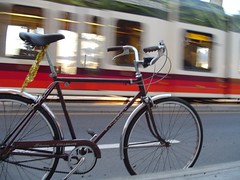
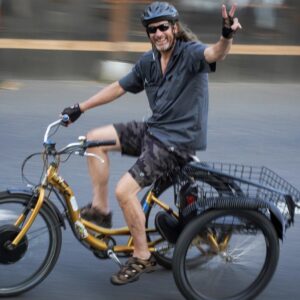
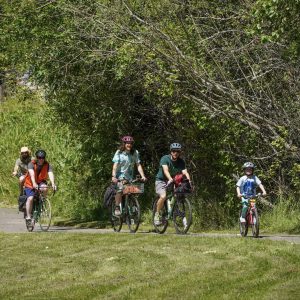
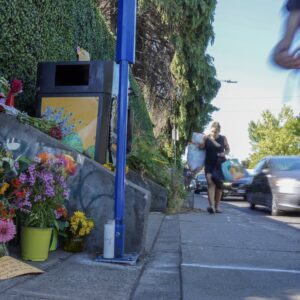
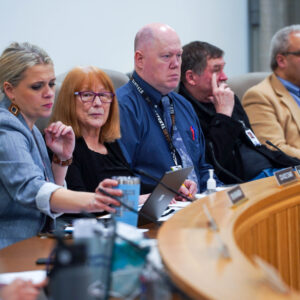
Thanks for reading.
BikePortland has served this community with independent community journalism since 2005. We rely on subscriptions from readers like you to survive. Your financial support is vital in keeping this valuable resource alive and well.
Please subscribe today to strengthen and expand our work.
Minor correction.
You said “That new line will run on SE Tacoma street, an easy pedal from the Springwater Corridor Trail.”
The new line does not run on Tacoma, it crosses under it going north/south, while Tacoma runs east/west.
Does this money have to be spent on bike parking or just around transit centers? Does it only have to be in the vicinity of transit?
Google Maps’ satellite view shows a dirt road running parallel to the eastside MAX line. Could the city declare eminent domain and then use these funds to build a Sullivan’s Gulch paved bike trail since it runs right next to transit? What about grabbing the dirt access road from the Zoo exit down to the Jefferson Street tunnel for a similar purpose? (Technically speaking it parallels westside MAX only above ground) Is there also a way to build a parallel bike route adjacent to the new Portland-Milwaukie MAX? Could the trolley that runs down to Lake Oswego during summer be considered “transit” and pave the way for a parallel bike path?
Bike freeways! High speed thoroughfares that make bikes just as fast or quicker than cars during rush hour. This would put outer Portland and suburbs that produce a lot of car traffic in play as “bikeable” commutes with long stretches protected from auto traffic and free from signals/control devices. Those are potential game changers that make the idea of riding attractive to more commuters.
Think big! Think beyond paint and close-in neighborhoods.
Seems like a logical partner for the Sullivan’s Gulch Trail.
I would add that by following the transit routes you could “connect” transit stations (to qualify for the funds) and encourage multi-modal trips.
I wouldn’t mind seeing some of that money used to provide better lighting on the Springwater Corridor.
As I recall, there are stretches that are completely dark…..
1500 feet?!?
No wonder there’s so many fatties nowadays.
So this is great for Portland for sure, but what about all the transit systems nationwide with few to no bike racks on buses, no bikes allowed on trains, and who are generally kind of hostile towards bicyclists? Is there some kind of “catch” in the policy that would make transit systems become more friendly to bikes if they want federal funding?
Wow…I feel like the PC Users on the new Windows commercials.
I have been saying for years: 1/4 mile walk to transit has been too short to plan routes. Instead: 1/2 mile to buses (10 blocks) and 1 mile (20 blocks) to rail and express buses. For bikes 3 miles or 60 blocks! All as a minimum!!!
A minimum that is until our neighborhood have more routes and transit with better (shorter) headways of 10 minutes or less.
As I understand it, making bike facilities within a certain distance of transit stations only makes them eligible for funding from FTA. That doesn’t mean those projects will be funded. There’s not enough funding for needed transit projects even without key bicycle and pedestrian elements. Now, if we increase the gas tax by $1.00 per gallon to fund transit/bike/pedestrian projects, we could really accomplish something. Follow the money – not the eligibility for funding.
The Metro travel demand forecasting model still fails to relate bike access improvements with increased transit ridership, so adding bike investments to a transit project’s already-fat budget does little to help the project get federal funding in the first place. This is because all major transit projects still need to go through the gauntlet of federal ‘cost effectiveness’ review. I suppose we’d be able to fund more bike projects if a transit project comes under budget though.
Regardless, the Portland-Milwaukie Light Rail project budget is already $1.4 billion and getting fatter by the minute. The most obvious place to look for bike funding from that project would be the planned park-and-ride structures. The park-and-rides are already fiercely opposed by the surrounding neighborhoods anyway.
Congratulations, Americans. This is good news for you all.
the seat post is bent; get a bigger bike!